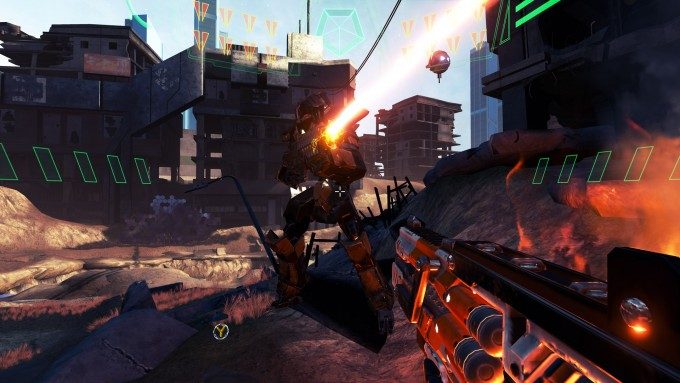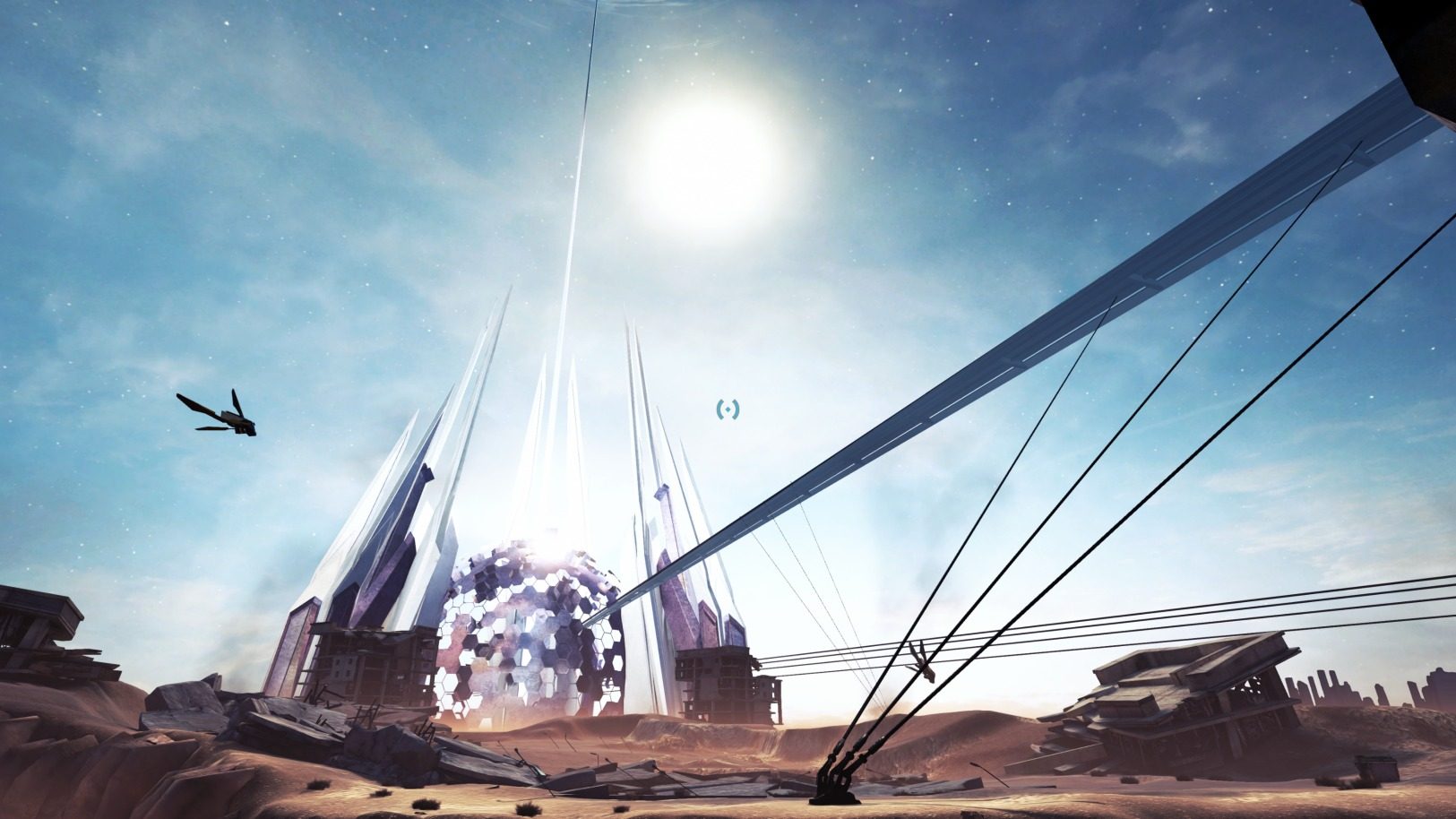Damaged Core is a first-person shooter set in the dingy near-future of a robot uprising. The Core, an artificial intelligence recently gone rogue, is destroying the Earth, and you, an AI program fighting on behalf of the humans, must hack your way closer to the Core by jumping from robot to robot.
Damaged Core Details:
Official Site
Developer: High Voltage Software, Inc.
Publisher: High Voltage Software, Inc.
Available On: Oculus Home (Rift)
Reviewed On: Oculus Rift with Xbox Controller
Release Date: August 30th, 2016
Gameplay
Being a non-corporeal computer program certainly has its perks, as you’re able to jump into hackable classes of robots and take over their hardware—that is until they’re predictably cut down into a pile of shreds. As Damaged Core‘s distinguishing game mechanic, jumping from bot to bot, it sets it apart from other VR first-person shooters by offering something genuinely unique to the genre, which mostly fall into one of two camps as of late: ported PC games originally destined for flat screens that offer smooth artificial locomotion, and shooting galleries that make you stay in one place. With its ingenious teleportation scheme, Damaged Core is neither and both.
The pace of action in Damaged Core rivals that of non-VR games even in the face of not having the use of your chosen robot’s legs. Among the 17 different classes spanning everything from multiple bi-pedal classes to hover tanks, you learn to zoom around at high-speed using different weapons, blasting the heads off of enemies, and getting your fair share of flak in the process. In fact, except for a single class of robot which has the ability to physically teleport itself around the map, I didn’t spend long in each bot because of how quickly the Core’s seemingly limitless forces react to your unexpected sabotage.
Needless to say, I kept my head (and my chair) on a swivel as I desperately searched for another available host to possess as your vision is slowly obscured over time to signal a fatal error in your hardware—the alternative being one of two options: death, or invariably retreating to one of the game’s many ‘safe zones’, a type of invisible camera drone whose high vantage points also make in-game navigation easier. Because of this, Damaged Core feels closer to the sort of frenetic first person shooters you see on PC and console.
The game tends to rely heavily on escort missions and ‘protect the thing for some reason’ missions as you make your way closer to disrupting the Core’s plans, a plain result of the game’s map structure. Maps are segmented into smaller stages with clear, linear goals that you have to accomplish to move forward like hacking terminals or busting power generators. After a while this can start to feel wooden as you methodically clear out the last wave of robots and hear the guiding hand of your AI-wrangler tell you where to go and what to do next. If you’ve ever played campaign-mode in any given game in the Halo franchise though, the level of hand-holding will be pretty familiar.
AI can be fumbly at moments, as enemies and allies have a knack for staring at walls and getting into corners, which is more noticeable near the end of battle sequences when there are only a few robots left on the map. Two times during the game I had to quit and restart from my last checkpoint to fix an impossible situation—my human allies wouldn’t move forward because there was a single enemy stuck at the beginning of the level just sitting there doing nothing. Because my squad had already progressed and around a corner, and the robot was above my skill level to hack combined with the fact that there weren’t any other baddies in sight, I had to redo that portion of the level. There was a similar occurrence on a train level—mere annoyances, because restarting doesn’t set you back that far, but annoyances non the less.
Damaged Core has eight levels in total which took me six hours to complete. Dying isn’t really that much of a setback, as the game automatically saves in small enough increments to put you back in front of the boss, or before specific mission objectives, so an average gamer should be able to get through well under the 10 hour suggested playtime cited by High Voltage.
Comfort
Since locomotion in the game is entirely based on teleportation, nausea is basically a non-issue. Rapid teleportation from host to host however can leave you disoriented, making either a swivel chair or a standing position an imperative so you can find your bearings quickly enough to get your guns trained on the right target—and by guns, I mean crosshairs locked to your face.
Personally, I hate gaze-based aiming systems in VR on principle, because they require you to use your neck as a fine pointing device—something it isn’t really designed for—and several hours can be overly taxing on your neck muscles. This is normally true when it comes to slower, more plodding games like VR Solitaire , but faster-paced games like Damaged Core seem to ameliorate this, as you’re constantly moving your head and fluidly readjusting for the perfect headshot.
If you’re prone to neck pains however, this may exacerbate things trying to get on the end-mission leader board, because headshots are prized over all else, and you really do need fine control of your gaze to achieve it.
Immersion
Using the Xbox One gamepad with Damaged Core, the only supported controller currently, isn’t my personal ideal. I would much rather shoot an offending bot in the head with my own two hands than using my gaze combined with a few choice trigger pulls on the gamepad. That said, Damaged Core does something I haven’t seen in a VR FPS, be it with gamepad or anything other input device. It delivers fast-paced, engaging action in a familiar package that proves to be easy to click into and easy to follow. There were only brief moments when I felt in charge of the battlefield, as the amount and variation of the enemy robots keeps you moving and shooting as fast as humanly possible.
Because of the limited teleportation points, there’s only a handful of moments when you can naturally take in the scale of the world, and really explore for the sake of admiring the game’s well realized backdrop. This is of course an FPS, and I should be more focused on shooting down hover tanks and reloading before I get to my last bullet than looking at a scenery, but this is the trade-off you get with Damaged Core’s past-paced, albeit limiting locomotion style.
An often overlooked piece of the puzzle is sound, and Damaged Core nails it with positional audio and a soundtrack clearly inspired by The Matrix (1999). It’s almost an imperative to keep an ear out for various enemies like ‘deconstructors’, the game’s omnipresent, slow-moving suicide drones. Not only that, but the positional audio helps keep you grounded in the world, giving you a natural point of reference as you pop in and out of enemy bots across the map.




